Abstract
Disk diffusion antimicrobial susceptibility testing of members of the family Legionellaceae was accomplished on buffered charcoal yeast extract agar by allowing the bacteria to grow for 6 h before placement of the disks, followed by an additional 42-h incubation period before the inhibitory zones were measured. This system was standardized by comparing the zone sizes with the MICs for 20 antimicrobial agents of nine bacterial strains in five Legionella species and of 19 laboratory-derived, erythromycin-resistant variants of Legionella micdadei. A high, linear correlation between zone size and MIC was found for erythromycin, trimethoprim, penicillin, ampicillin, carbenicillin, cephalothin, cefamandole, cefoxitin, moxalactam, chloramphenicol, vancomycin, and clindamycin. Disk susceptibility testing could be employed to screen Legionella isolates for resistance to any of these antimicrobial agents, of which only erythromycin is known to be efficacious in the treatment of legionellosis. With selected antibiotics, disk susceptibility patterns also appeared to accurately identify to the species level the legionellae. The range of the MICs of the legionellae for rifampin and the aminoglycosides was too small to determine whether the correlation of zone size with MIC was linear. However, laboratory-derived, high-level rifampin-resistant variants of L. micdadei demonstrated no inhibition zone around the rifampin disk, indicating that disk susceptibility testing would likely identify a rifampin-resistant clinical isolate. Of the antimicrobial agents tested, the only agents for which disk susceptibility testing was definitely not possible on buffered charcoal yeast extract agar were oxacillin, the tetracyclines, and the sulfonamides.
Full text
PDF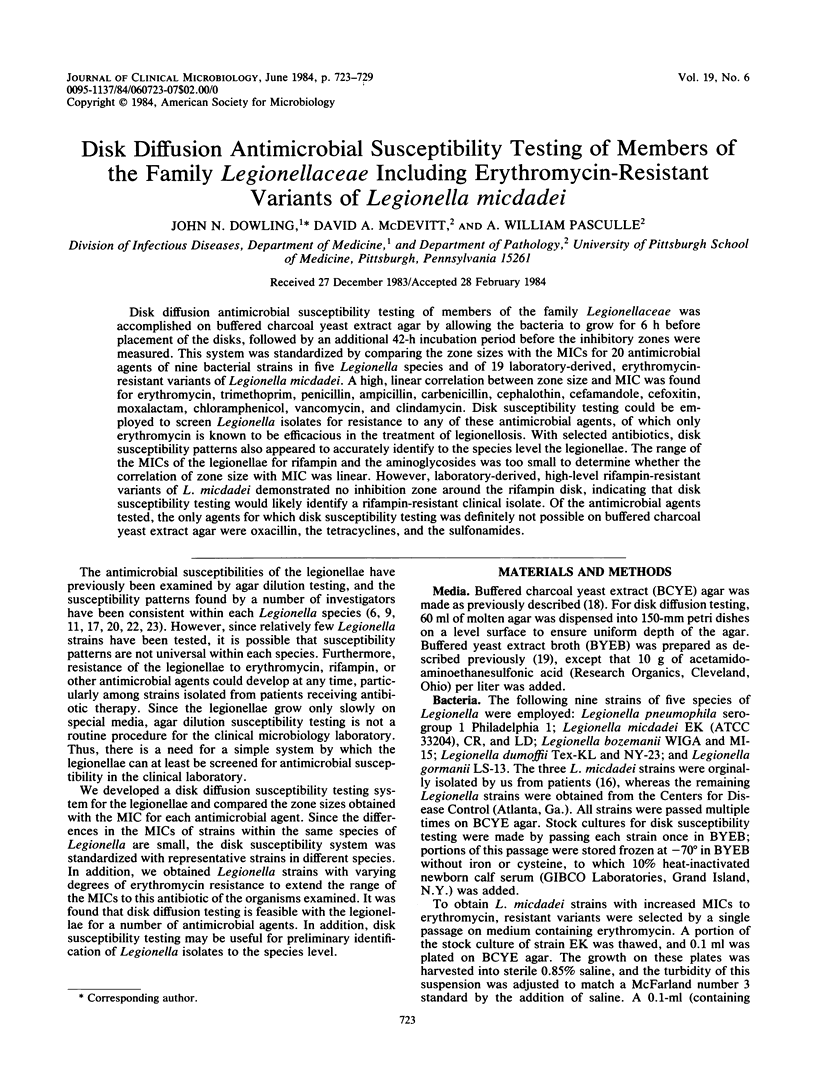
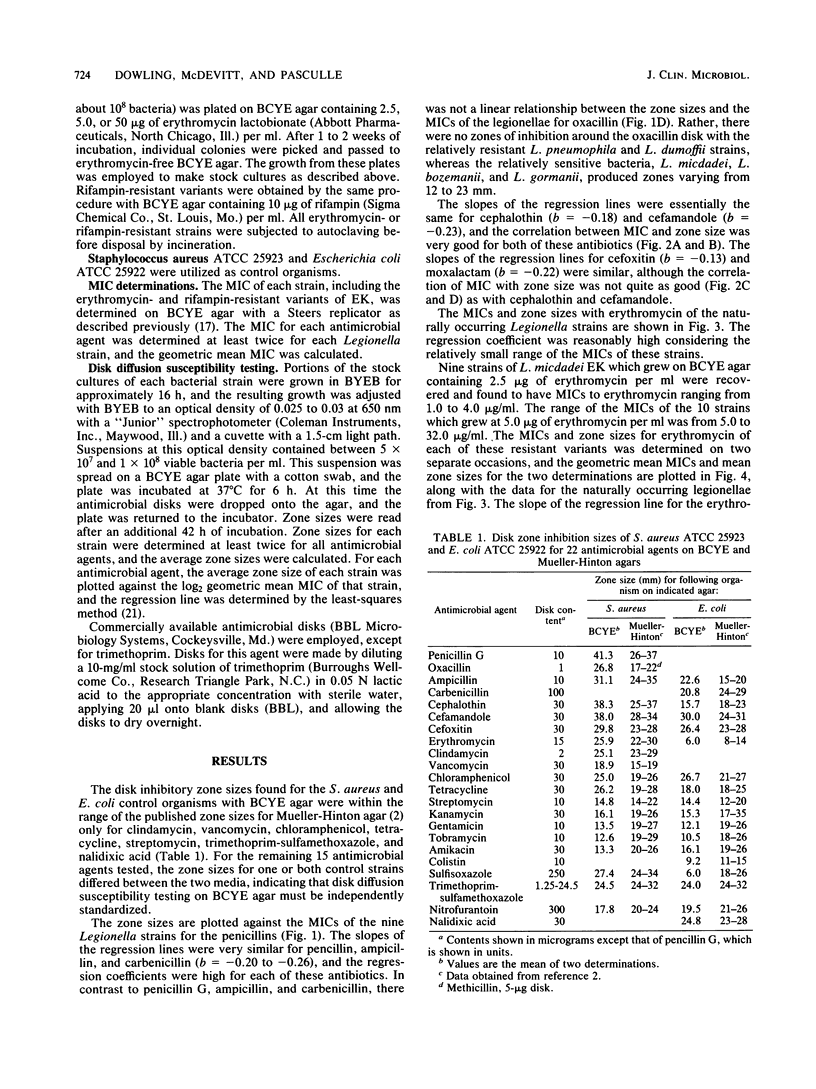
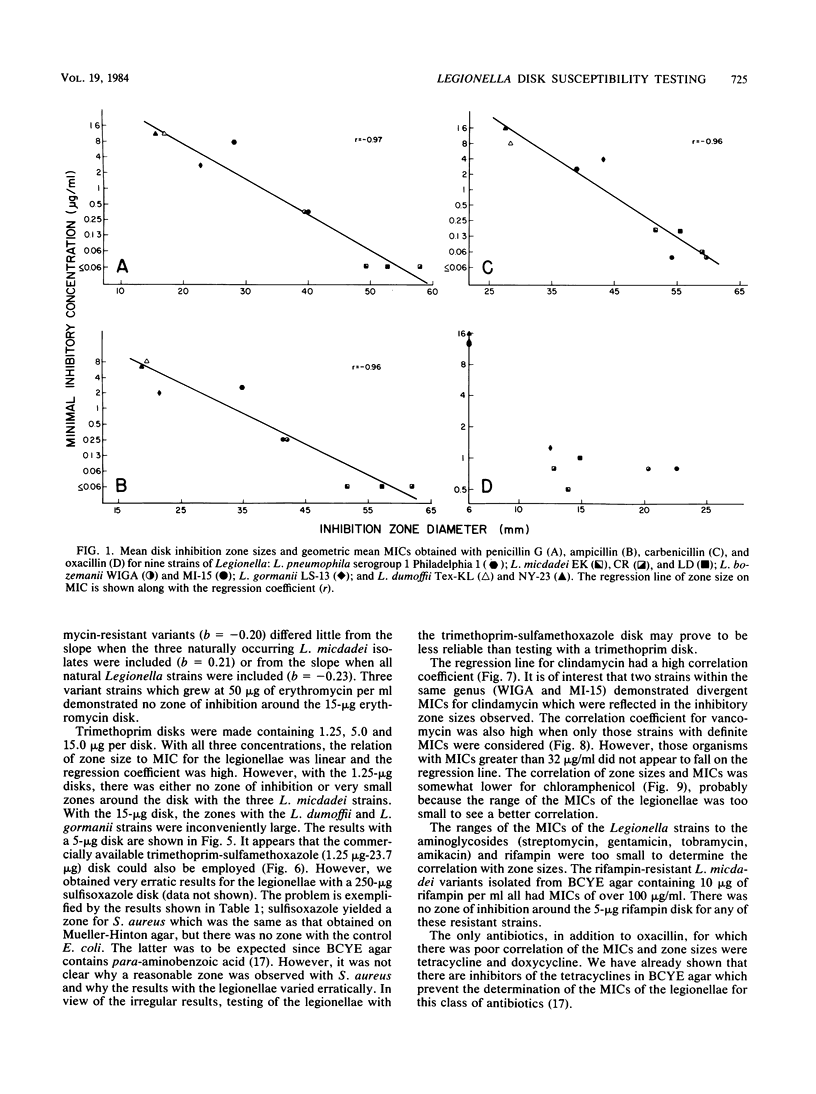
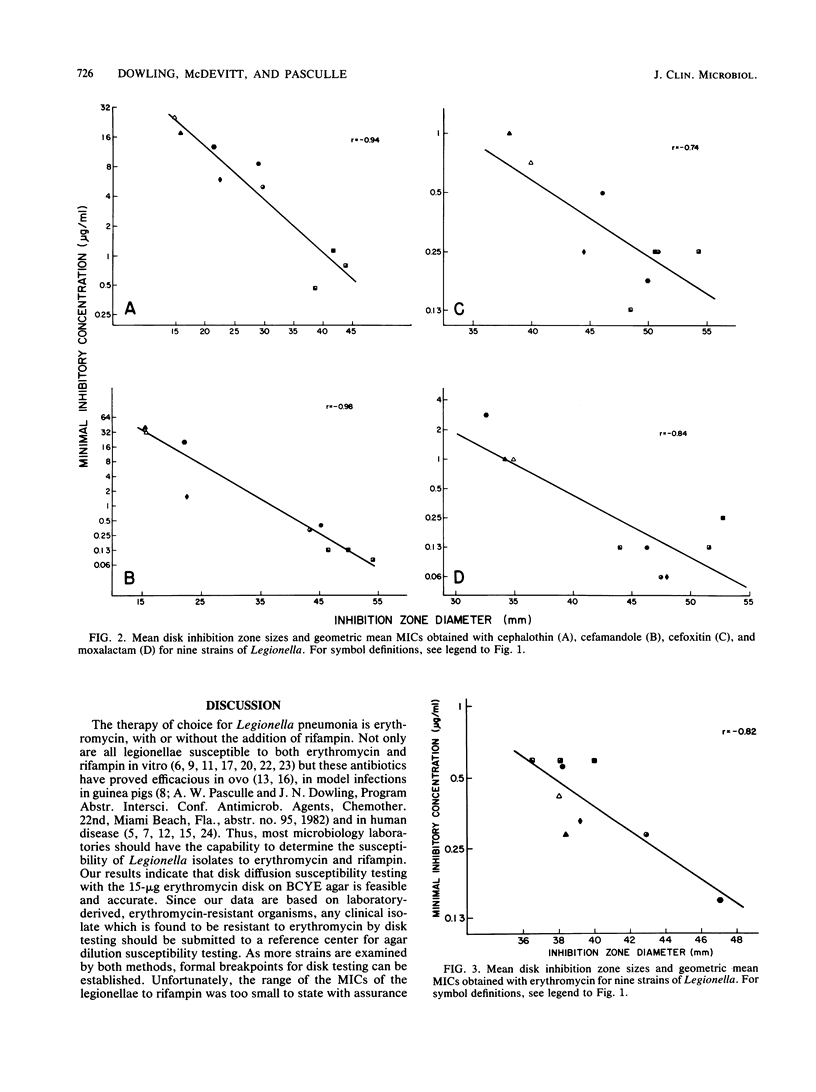
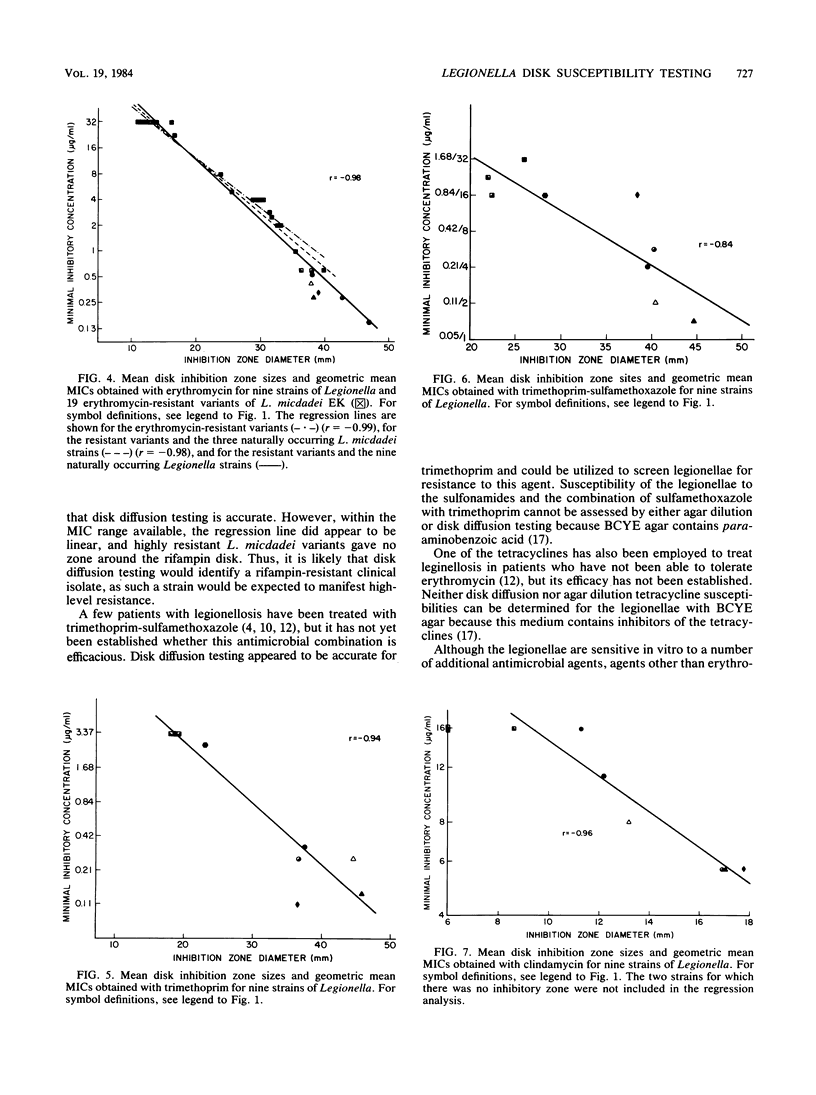
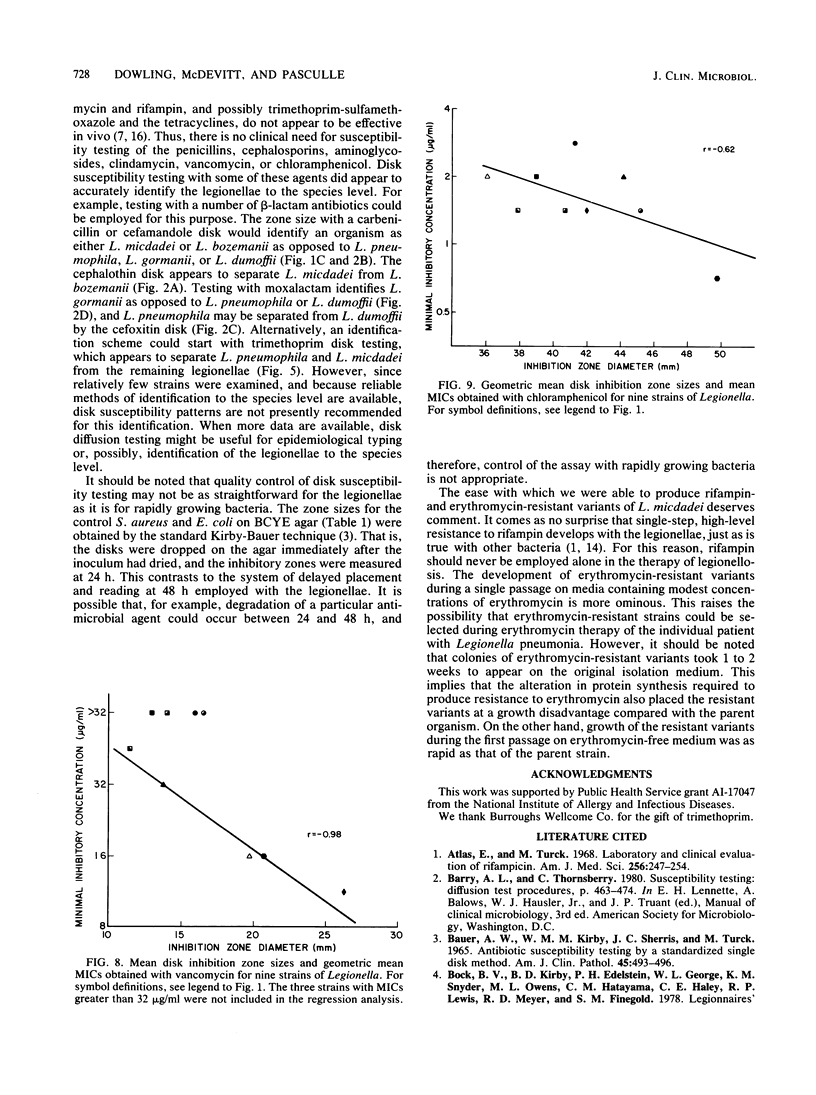
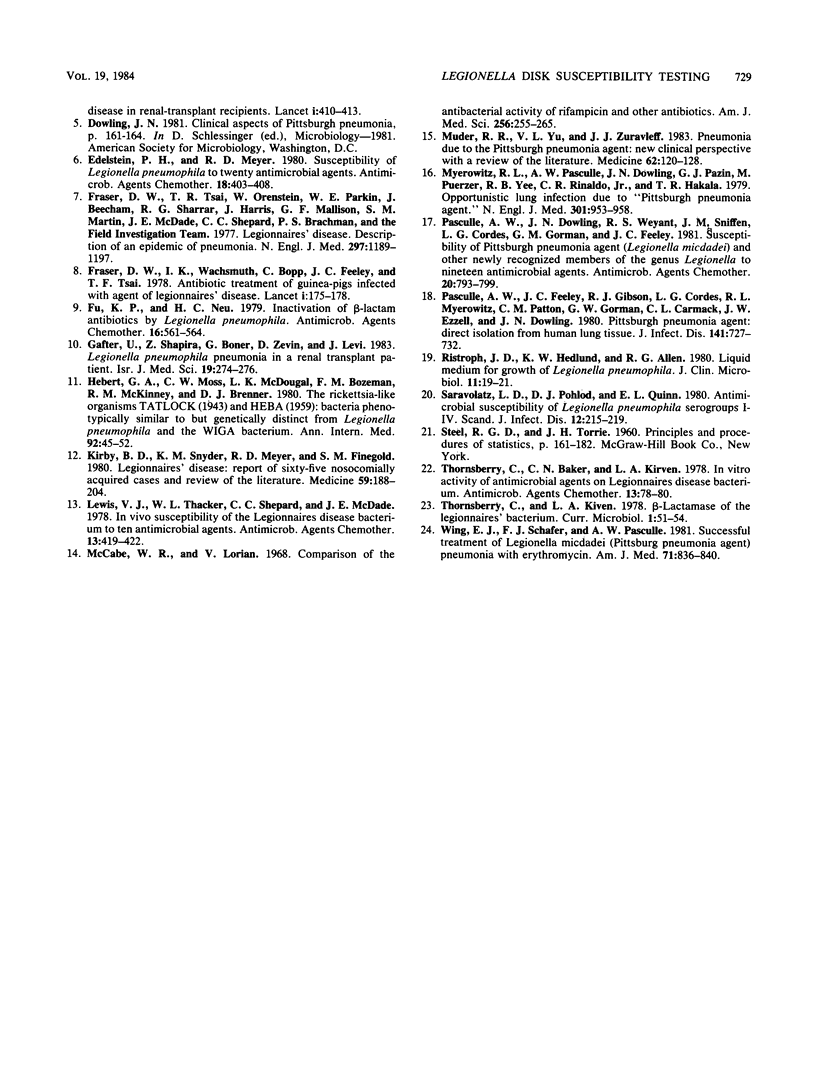
Selected References
These references are in PubMed. This may not be the complete list of references from this article.
- Bauer A. W., Kirby W. M., Sherris J. C., Turck M. Antibiotic susceptibility testing by a standardized single disk method. Am J Clin Pathol. 1966 Apr;45(4):493–496. [PubMed] [Google Scholar]
- Edelstein P. H., Meyer R. D. Susceptibility of Legionella pneumophila to twenty antimicrobial agents. Antimicrob Agents Chemother. 1980 Sep;18(3):403–408. doi: 10.1128/aac.18.3.403. [DOI] [PMC free article] [PubMed] [Google Scholar]
- Fraser D. W., Tsai T. R., Orenstein W., Parkin W. E., Beecham H. J., Sharrar R. G., Harris J., Mallison G. F., Martin S. M., McDade J. E. Legionnaires' disease: description of an epidemic of pneumonia. N Engl J Med. 1977 Dec 1;297(22):1189–1197. doi: 10.1056/NEJM197712012972201. [DOI] [PubMed] [Google Scholar]
- Fraser D. W., Wachsmuth I., Bopp C., Feeley J. C., Tsai T. F. Antibiotic treatment of guinea-pigs infected with agent of Legionnaires' disease. Lancet. 1978 Jan 28;1(8057):175–178. doi: 10.1016/s0140-6736(78)90611-6. [DOI] [PubMed] [Google Scholar]
- Fu K. P., Neu H. C. Inactivation of beta-lactam antibiotics by Legionella pneumophila. Antimicrob Agents Chemother. 1979 Nov;16(5):561–564. doi: 10.1128/aac.16.5.561. [DOI] [PMC free article] [PubMed] [Google Scholar]
- Gafter U., Shapira Z., Boner G., Zevin D., Levi J. Legionella pneumophila pneumonia in a renal transplant patient. Isr J Med Sci. 1983 Mar;19(3):274–276. [PubMed] [Google Scholar]
- Hébert G. A., Moss C. W., McDougal L. K., Bozeman F. M., McKinney R. M., Brenner D. J. The rickettsia-like organisms TATLOCK (1943) and HEBA (1959): bacteria phenotypically similar to but genetically distinct from Legionella pneumophila and the WIGA bacterium. Ann Intern Med. 1980 Jan;92(1):45–52. doi: 10.7326/0003-4819-92-1-45. [DOI] [PubMed] [Google Scholar]
- Kirby B. D., Snyder K. M., Meyer R. D., Finegold S. M. Legionnaires' disease: report of sixty-five nosocomially acquired cases of review of the literature. Medicine (Baltimore) 1980 May;59(3):188–205. [PubMed] [Google Scholar]
- Lewis V. J., Thacker W. L., Shepard C. C., McDade J. E. In vivo susceptibility of the Legionnaires disease bacterium to ten antimicrobial agents. Antimicrob Agents Chemother. 1978 Mar;13(3):419–422. doi: 10.1128/aac.13.3.419. [DOI] [PMC free article] [PubMed] [Google Scholar]
- McCabe W. R., Lorian V. Comparison of the antibacterial activity of rifampicin and other antibiotics. Am J Med Sci. 1968 Oct;256(4):255–265. doi: 10.1097/00000441-196810000-00007. [DOI] [PubMed] [Google Scholar]
- Muder R. R., Yu V. L., Zuravleff J. J. Pneumonia due to the Pittsburgh pneumonia agent: new clinical perspective with a review of the literature. Medicine (Baltimore) 1983 Mar;62(2):120–128. doi: 10.1097/00005792-198303000-00005. [DOI] [PubMed] [Google Scholar]
- Myerowitz R. L., Pasculle A. W., Dowling J. N., Pazin G. J., Sr, Puerzer M., Yee R. B., Rinaldo C. R., Jr, Hakala T. R. Opportunistic lung infection due to "Pittsburgh Pneumonia Agent". N Engl J Med. 1979 Nov 1;301(18):953–958. doi: 10.1056/NEJM197911013011801. [DOI] [PubMed] [Google Scholar]
- Pasculle A. W., Dowling J. N., Weyant R. S., Sniffen J. M., Cordes L. G., Gorman G. M., Feeley J. C. Susceptibility of Pittsburgh pneumonia agent (Legionella micdadei) and other newly recognized members of the genus Legionella to nineteen antimicrobial agents. Antimicrob Agents Chemother. 1981 Dec;20(6):793–799. doi: 10.1128/aac.20.6.793. [DOI] [PMC free article] [PubMed] [Google Scholar]
- Pasculle A. W., Feeley J. C., Gibson R. J., Cordes L. G., Myerowitz R. L., Patton C. M., Gorman G. W., Carmack C. L., Ezzell J. W., Dowling J. N. Pittsburgh pneumonia agent: direct isolation from human lung tissue. J Infect Dis. 1980 Jun;141(6):727–732. doi: 10.1093/infdis/141.6.727. [DOI] [PubMed] [Google Scholar]
- Ristroph J. D., Hedlund K. W., Allen R. G. Liquid medium for growth of Legionella pneumophila. J Clin Microbiol. 1980 Jan;11(1):19–21. doi: 10.1128/jcm.11.1.19-21.1980. [DOI] [PMC free article] [PubMed] [Google Scholar]
- Saravolatz L. D., Pohlod D. J., Quinn E. L. Antimicrobial susceptibility of Legionella pneumophila Serogroups I--IV. Scand J Infect Dis. 1980;12(3):215–219. doi: 10.3109/inf.1980.12.issue-3.09. [DOI] [PubMed] [Google Scholar]
- Thornsberry C., Baker C. N., Kirven L. A. In vitro activity of antimicrobial agents on Legionnaires disease bacterium. Antimicrob Agents Chemother. 1978 Jan;13(1):78–80. doi: 10.1128/aac.13.1.78. [DOI] [PMC free article] [PubMed] [Google Scholar]
- Wing E. J., Schafer F. J., Pasculle A. W. Successful treatment of Legionella micdadei (Pittsburgh pneumonia agent) pneumonia with erythromycin. Am J Med. 1981 Nov;71(5):836–840. doi: 10.1016/0002-9343(81)90376-4. [DOI] [PubMed] [Google Scholar]


